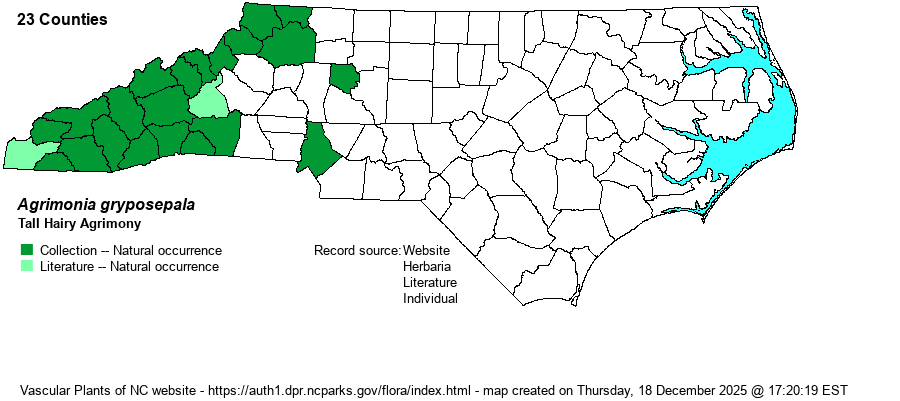| Author | Wallroth | |
| Distribution | Primarily limited to the Mountains, and likely is present in all counties. Ranges into the western Piedmont to an undetermined extent. A few records well to the east are likely misidentifications and are not shown on the map.
This is a widespread Northern and Western species, ranging from Canada south to PA, IL, and IA, south mainly in the Appalachians to northern GA and northern AL. | |
| Abundance | Fairly common to frequent in the Mountains, probably less numerous in the far southwestern counties, as that lies near the edge of the range. Very rare, if correctly identified, in the western parts of the Piedmont. | |
| Habitat | This is a species of rich soil, often high in pH; it grows in wet woods, rich forested slopes, bogs, marshes, and moist forest edges. In uplands, the soils need to be fairly high pH. | |
| Phenology | Blooms in July and August, and fruits from July to October. | |
| Identification | The genus Agrimonia has numerous species with distinctive leaves and flowering stalk, but the characters to separate many are quite technical, and biologists may have trouble keying them out. All have erect stems ranging in the vicinity of 3 feet tall, with alternate leaves that are distinctly pinnately compound, with small leaflets intermixed with much larger ones. Also, the inflorescence is a very long and slender spike-like raceme of tiny yellow flowers; these plants should be easily identified to genus level. In this species, the stem is stout and may reach up to 4 feet tall. This and several other species -- A. rostellata, A. striata, and A. parviflora -- all have glistening glands along the stem and axis of the raceme. This species and A. rostellata have these glands short stalked (use a hand lens), versus all glands sessile in the other two species. This species, being robust, has the stipules at the bases of the leaves quite large and leaf-like, about 1/2-inch long, and cordate at the base. Its large leaflets are rather long and sharply serrated, elliptic, and about 3 inches long; and there may often be two pairs of small leaflets between larger ones. A. rostellata, which also occurs in the mountains, is a smaller species, reaching about 3 feet tall, but its leaflets are more obovate (rounded), with smaller teeth, and there is almost always just one pair of small leaflets between the larger ones. Note that the equally robust A. parviflora has 11-15 large leaflets (that is, 5-7 pairs plus a large one at the end); all other NC species have only 9 or fewer large leaflets (4 pairs or fewer, plus the terminal one). | |
| Taxonomic Comments | None
| |
| Other Common Name(s) | Common Agrimony, Swamp Agrimony, Tall Agrimony | |
| State Rank | S3 | |
| Global Rank | G5 | |
| State Status | | |
| US Status | | |
| USACE-agcp | FACU link |
| USACE-emp | FACU link |

